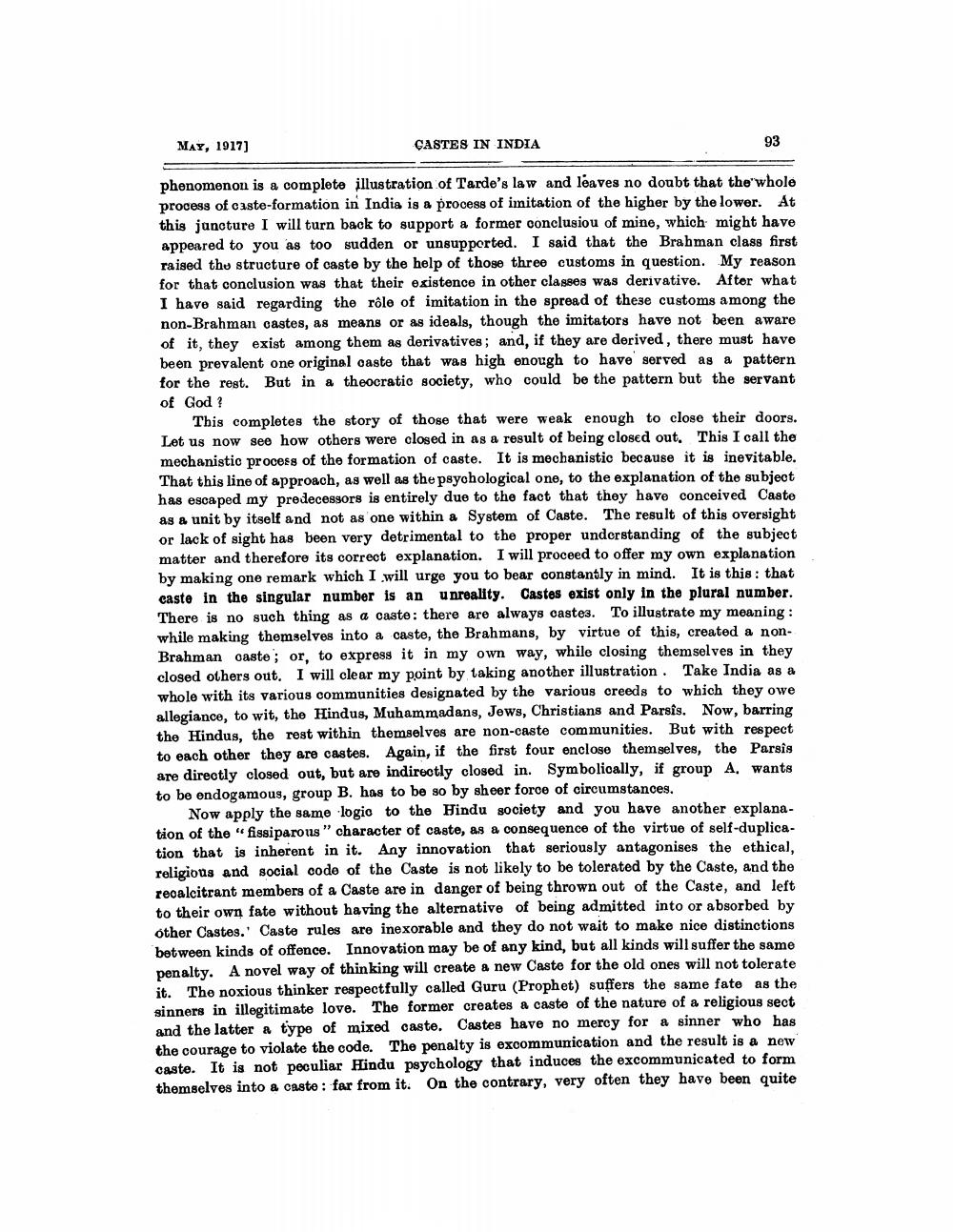________________
MAY, 1917)
CASTES IN INDIA
93
phenomenon is a complete illustration of Tarde's law and leaves no doubt that the whole process of caste-formation in India is a process of imitation of the higher by the lower. At this juncture I will turn back to support a former conclusiou of mine, which might have appeared to you as too sudden or unsupported. I said that the Brahman class first raised the structure of caste by the help of those three customs in question. My reason for that conclusion was that their existence in other classes was derivative. After what I have said regarding the role of imitation in the spread of these customs among the non-Brahman castes, as means or as ideals, though the imitators have not been aware of it, they exist among them as derivatives; and, if they are derived, there must have been prevalent one original caste that was high enough to have served as a pattern for the rest. But in a theocratic society, who could be the pattern but the servant of God?
This completes the story of those that were weak enough to close their doors. Let us now see how others were closed in as a result of being closed out. This I call the mechanistic process of the formation of caste. It is mechanistic because it is inevitable. That this line of approach, as well as the psychological one, to the explanation of the subject has escaped my predecessors is entirely due to the fact that they have conceived Caste as a unit by itself and not as one within a System of Caste. The result of this oversight or lack of sight has been very detrimental to the proper understanding of the subject matter and therefore its correct explanation. I will proceed to offer my own explanation by making one remark which I will urge you to bear constantly in mind. It is this: that casto in the singular number is an unreality. Castes exist only in the plural number. There is no such thing as a caste: there are always castes. To illustrate my meaning: while making themselves into a caste, the Brahmans, by virtue of this, created a nonBrahman oaste; or, to express it in my own way, while closing themselves in they closed others out. I will clear my point by taking another illustration. Take India as a whole with its various communities designated by the various creeds to which they owe allegiance, to wit, the Hindus, Muhammadans, Jews, Christians and Parsis. Now, barring the Hindus, the rest within themselves are non-caste communities. But with respect to each other they are castes. Again, if the first four enclose themselves, the Parsis are directly closed out, but are indirectly closed in. Symbolically, if group A, wants to be ondogamous, group B. has to be so by sheer force of circumstances.
Now apply the same logic to the Hindu society and you have another explanation of the "fissiparous" character of caste, as a consequence of the virtue of self-duplication that is inherent in it. Any innovation that seriously antagonises the ethical, religious and social code of the Caste is not likely to be tolerated by the Caste, and the recalcitrant members of a Caste are in danger of being thrown out of the Caste, and left to their own fate without having the alternative of being admitted into or absorbed by other Castes.' Caste rules are inexorable and they do not wait to make nice distinctions between kinds of offence. Innovation may be of any kind, but all kinds will suffer the same penalty. A novel way of thinking will create a new Caste for the old ones will not tolerate it. The noxious thinker respectfully called Guru (Prophet) suffers the same fate as the sinners in illegitimate love. The former creates a caste of the nature of a religious sect and the latter a type of mixed caste. Castes have no mercy for a sinner who has the courage to violate the code. The penalty is excommunication and the result is a new caste. It is not peculiar Hindu psychology that induces the excommunicated to form themselves into a caste: far from it. On the contrary, very often they have been quite




